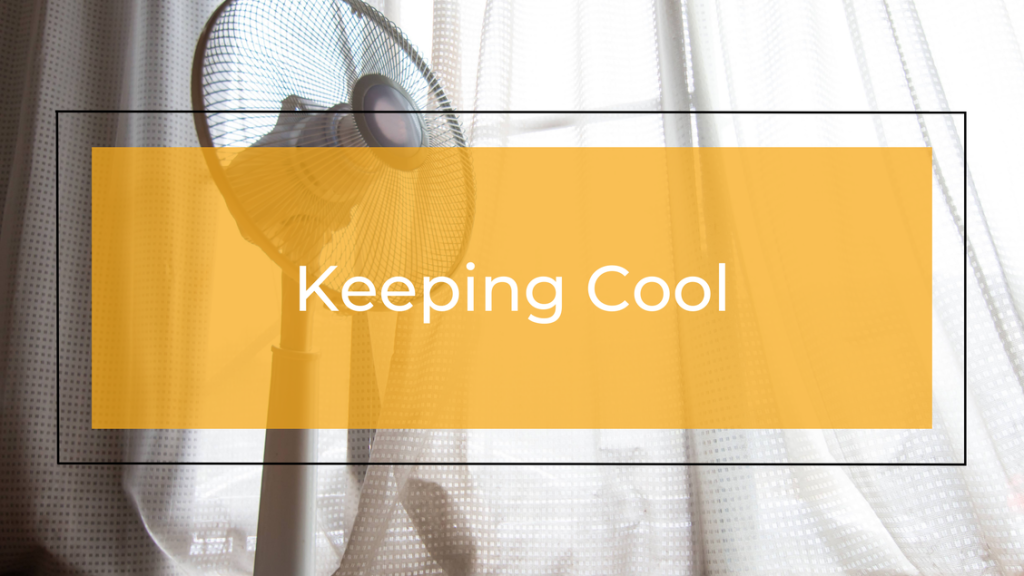Windows: Strategically raising and lowering windows is an age-old way to reduce heat buildup in your house and significantly reduce your need for air conditioners except on the hottest days. Opening windows at night will pull in cool air; opening sash windows top and bottom and cross-ventilating will circulate the air; and closing windows early in the morning will keep hot air out as the day warms. Close window blinds and curtains during the day, particularly when sun is beating on them. For other no-cost ways to prevent heat buildup, check out JCED’s tip sheet here.
Fans: Fans don’t actually cool the air but, by getting the air moving, they make you feel cooler. Used in conjunction with opening windows at night, they will also circulate and mix cooler air with warm, stagnant air.
- Furnace fans. Turn your thermostat to “fan only” (when the heat or cool system is turned off) to circulate cool basement air throughout the house.
- Box fans can be used both as exhaust fans to blow hot air out through your windows or, when outside air is cool, to blow the cool air in. Box and other fans can be set beside cool air vents or air conditioners to speed up the cooling process.
- Ceiling fans create a breeze to cool your skin. They should be set in a counter-clockwise rotation in the summer to pull warm air up and in a clock-wise motion in winter to blow warm air down.
Whole-house fans can ventilate and cool a house with a fraction of the energy and far less cost ($200-300 versus $2000-4000) than air conditioners. These fans are set into the ceiling of the top floor, where they pull cooler outside air inside through open windows, push hot air into the attic and out through the vents. As stated above, fans do not cool or dehumidify the air, so operating them on a hot and humid day will not provide much relief. Tips on evaluating your home for a whole-house fan can be found here.
AC Window Units: If you plan to air-condition a relatively small place, window or wall units might be a good choice. They are readily available at competitive prices, can cool spaces from 100 SF to 650 SF efficiently and relatively quietly. Use fans near window units to speed up their cooling effect. The most efficient room AC units can be found here.
Central Air: Unlike single-room units, central AC systems cool air in a central location and circulate it through supply and return ducts throughout the house. Central AC dehumidifies and filters the air, improving indoor air quality. It is quiet, out-of-the-way, and convenient to operate but it is also much more expensive to install ($2000-4000) and operate. To optimize use of central air, set temperature at 78 degrees when you’re at home and raise it 3 to 5 degrees when you’re gone. Contrary to belief, it is more efficient to raise or lower the thermostat when you’re gone rather than maintain a steady temperature in the house. Leaving the AC run all day is a very inefficient way to keep cool and is very costly. A programmable thermostat will start cooling the house an hour before you return. As above, use fans near air vent to speed up and maximize cooling effect at much less cost. Energy Star air conditioning, with rebates, are found here.
Heat pumps are an innovative technology that provide both cool air in the summer and warm air in the winter more efficiently than air conditioners and furnaces. They also dehumidify and purify air, making them almost magical! In the past, heat pumps were not recommended for the Upper Midwest, but technological improvements are changing that. In-depth information about heat pumps can be found here. Additionally, President Biden recently invoked the Defense Production Act to accelerate domestic production of five clean energy technologies, including heat pumps, so the cost and availability of this technology should improve significantly in coming months. If you will be in the market for a new AC or furnace in the next few years, check these out!
Rebates
MidAmerican Energy 2022 Iowa Residential Rebates
Alliant Energy (Interstate Power and Light) Energy Efficiency Rebates
Linn County REC Residential Energy Efficiency Rebates
Read the entire Good Energy Newsletter, Summer 2022

